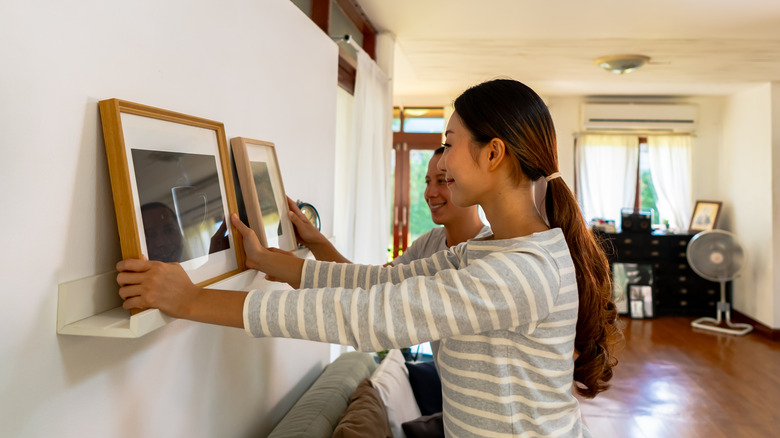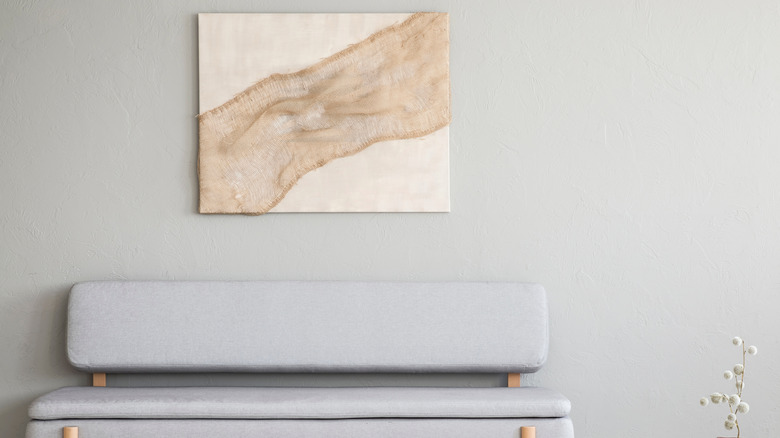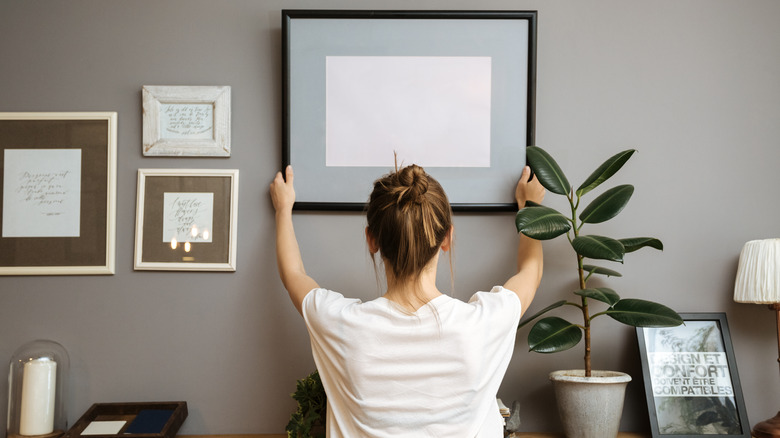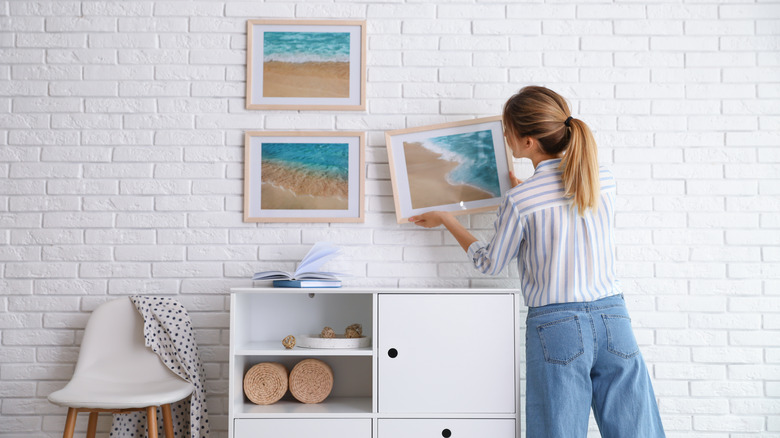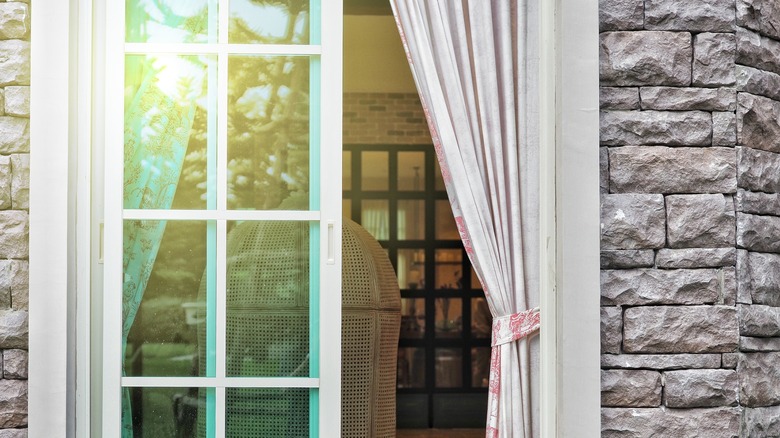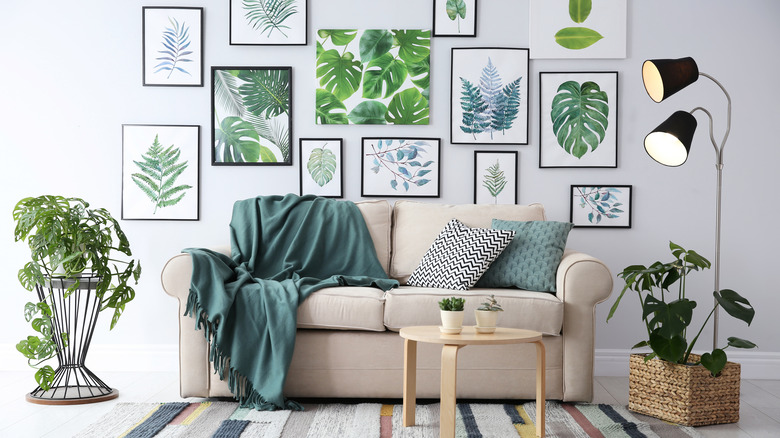Common Mistakes People Make When Hanging Artwork On Their Walls
Even if every piece of furniture you've selected for your home has been picked with care and consideration, without a few decor accents, a space can fall flat and end up being a little bit underwhelming. That's why art is such a game changer when it comes to your home decor — not only is art absolutely gorgeous, it can also add a serious impact to your space, and allow you to express your personality a bit.
Though many people with more modest budgets assume that all art is too expensive, the reality is there's something out there for just about every price point. Sure, you probably won't be splurging on a piece from a world-renowned artist if you're on a tight budget, but you can often find reasonably-priced pieces at local art shows, from new artists just starting out, at thrift stores or flea markets, etc. Heck, if you're feeling particularly crafty and inspired, as Country Living explores, there are even DIY tutorials for all kinds of art projects that you can whip up yourself for nothing but the cost of materials and a bit of time.
However, even if you find the perfect piece, there are a few things to consider. Here are five common mistakes that people make when hanging artwork on their walls. Take them into consideration when you're adding art to your space and you'll never go wrong.
Hanging artwork at the wrong level
Sure, everyone can tell when a piece of art has been hung crooked, but can you tell when it has been hung far too high? According to Apartment Therapy, this is by far the most common mistake people make when hanging art because, well, it's tough to figure out exactly where that sweet spot is. Luckily, there are a few helpful rules of thumb.
If a piece of art is hanging on a wall with no furniture or other design elements nearby, you should try to hang it at about eye level, according to Jennifer Squires Productions. However, that may not be the right fit for everyone — if your space has low ceilings, or you're taller than most, you may want to consider a tip from The DIY Playbook and visually divide your wall into four vertical sections, placing your piece of art in the third section up from the floor.
For a piece hanging above some furniture, like a couch, you'll need to take the furniture into consideration; a range of about 6 to 10 inches above the top of the furniture makes the artwork look like it was hung with intention, and can also prevent any mishaps from people bumping the piece. Considering a gallery wall or collection of pieces? Think of them as one larger collection, making sure neither top nor bottom of the layout are too high or low.
Picking artwork that's the wrong scale for the space
If you find a piece of art you absolutely love, it's tempting to add it to any area in your home where you'll see it most. However, one of the most common mistakes people make when putting up artwork is selecting something that's the wrong size for the space it's in, per Apartment Therapy. In most cases, this means that people are selecting pieces that are far too small. While it can feel scary to make a major statement with a large piece, often something sizable is needed for the art to really work in a space.
One rule of thumb from The DIY Playbook is to take the piece of furniture you're placing the artwork above (such as a couch or bed) and select a piece of art that fills a minimum of two-thirds of the space. It may seem large, but visually, it should work well. If there are smaller prints you absolutely love, you can always re-frame them in a larger frame with more white space, or alternatively, group two or three pieces together to create one larger collective piece. While you may think of every image in a trio or even a gallery wall as its own piece (and they are), on the wall itself, you can consider the overall size of the whole group when determining whether the scale works.
Not hanging artwork securely enough
You've hung a piece of art, you think it looks absolutely fantastic, and then all of a sudden when you're off doing something in another room you hear a loud crash — and rush in to find your beloved piece of art laying on the floor. Many of us have been in that situation, which is why it's one of the most common mistakes that people make when hanging artwork. After all, no matter what piece you select, if you don't hang it properly, it'll likely end in disaster.
When you hang any piece of artwork, according to House & Home, you want to ensure that the hook (or whatever you're hanging it by) is the right strength for the piece of art. In an ideal world, you'll also want to find a space where you can screw the hook into a wall stud, which can bear a bit more weight than your regular wall can (via Mental Floss). Alternatively, you can find something specifically designed for unreinforced walls, or add some support with a wall anchor if you want to hang your piece somewhere there are no studs. Finally, take the area into consideration — if a piece is hung in a high-traffic spot, you may want to add some extra reinforcements in order to ensure your piece doesn't go askew every time you close a door.
Forgetting to think about the glare
If the piece of art you've chosen to hang is a canvas, unframed textile, or something along those lines, you don't need to worry about this. However, the reality is the vast majority of art, from prints to photographs to framed textiles, comes in frames with a layer of glass. This helps protect the art, and can also add a whole different element of style, depending on the type of frame you choose. A frame can even change the dimensions of a piece — by selecting a large frame with plenty of white space around the image, you can make a smaller piece fit into a space that requires a larger item for scale.
There's just one downside of frames, though: the glare — especially if you're hanging a piece of art in a room with a lot of lights or windows. According to Maison de Pax, you'll want to be aware of where the glare is coming from and how it impacts your artwork. After all, there's no point in hanging something if every day the light coming from a nearby window creates insane glare to the point where you can't even tell what's in the frame. If there's an area that receives a lot of light and has a high potential for glare, you may want to consider an unframed piece to allow the artwork to really shine.
Being too matchy-matchy
Many art lovers have had the experience of stumbling across a piece that just captures their heart, the type of piece you absolutely must buy — you'll figure out exactly where and how to incorporate it into your space later, right? Well, in many rooms, it can be tough to decide on what type of art would look best.
One common mistake that people make is selecting pieces that are too matchy-matchy, as Apartment Therapy says. While it can look visually appealing to incorporate some of the color palette of the space into a piece of art hanging within it, many people make the mistake of being restricted by that parameter.
Obviously, you don't want a piece with a color palette, pattern, or image that clashes with the rest of the room and fights for attention in a negative way. However, you also don't need to restrict yourself to finding pieces from a limited color palette in order to have them work in the room. In reality, it's a bit of a balancing act — you want the art to be in harmony with the rest of the space, but a little contrast can be a good thing. There's nothing like a neutral room with a few pops of color courtesy of the eye-catching artwork.
